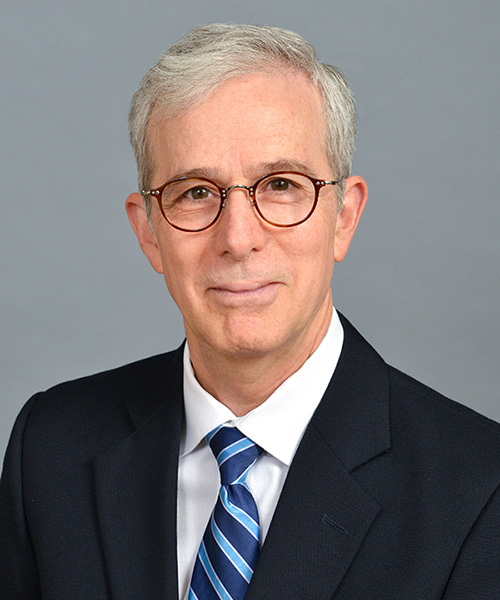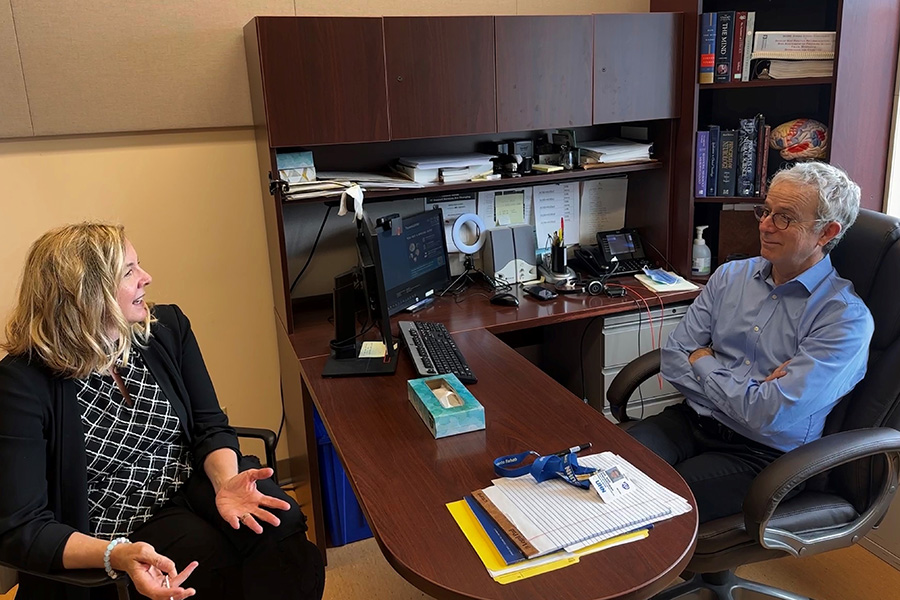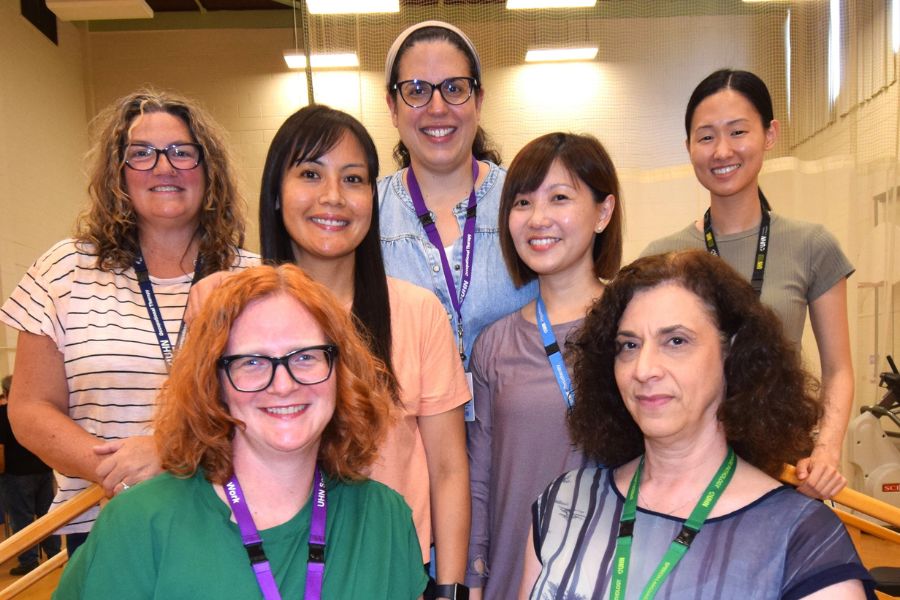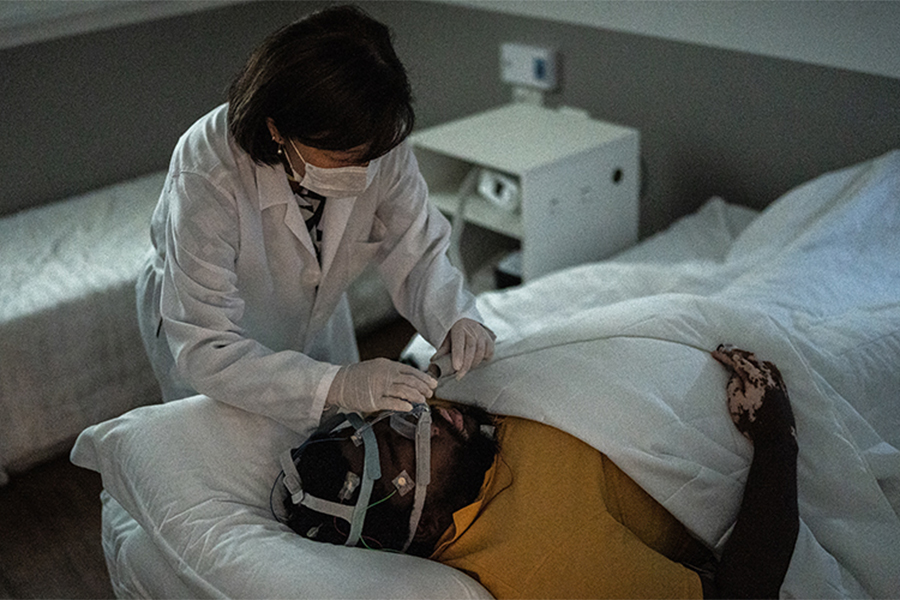
In 2010, Christine Papoushek was 39 and working a typical day at Toronto Western Hospital as a pharmacist, when she suffered an ischemic stroke.
Ischemic strokes are caused when there is a blockage in an artery, commonly a blood clot, which prevents blood supply to the brain. Onset of a stroke can be quick and requires immediate medical assistance but is treatable.
Christine was admitted to the Emergency Department at Toronto Western, where the clot dissolved before any further treatment was needed. She was then kept as an inpatient for six days at the Neurovascular Unit to run diagnostic tests.
Although Christine was fortunate to not have experienced any lingering physical implications from the stroke, which can include paralysis, loss of balance or impaired speech, she was unaware of the cognitive and emotional effects that were more invisible.
Looking healthy from the outside, she went back to her everyday life at home with her partner and three children.
However, it soon became clear that how she looked and how she felt were much different.
“After my stroke, I was starting to not recognize myself,” Christine says. “I felt hopeless and like I had been hit by a truck.
“I could barely do anything without needing a rest. I knew I needed help.”
Christine went to her family doctor, who referred her to Toronto Rehab‘s Outpatient Stroke Services for further assessment.
“Once I was referred to Toronto Rehab, everything started to fall into place,” she says. “The staff immediately recognized that I was not receiving the resources I needed for my mental health and provided just that.”
Christine’s need for sleep is a common symptom after a stroke. As the brain tries to recover, most of a patient’s energy will be used in the process.
However, her feeling of hopelessness was a sign of depression.

The unique connection between women and stroke
Care teams at Toronto Rehab are leaders in brain rehabilitation in Canada. They recognize there can be a gap in care for patients who are affected not only physically – but also mentally – after a stroke.
Understanding this as part of providing high-quality stroke care helped Toronto Rehab’s Inpatient Stroke Services recently earn “Distinction in Stroke Services” for a fifth consecutive Stroke Accreditation cycle.
However, Toronto Rehab’s stroke care continues far after the patient leaves the hospital. This includes providing patients with options for post-stroke cognitive rehabilitation programming regardless of whether they are presenting signs of depression and anxiety.
Through programs such as the Outpatient Stroke Services, patients access the care they need at every stage and area of stroke recovery.
“Stroke is a brain illness, but depression is too,” says Dr. Abe Snaiderman, Director of the Neuropsychiatry Clinic at Toronto Rehab. “Where women can suffer more is that they often put their own needs aside to care for others and don’t take the necessary time to heal.”

The Neuropsychiatry Clinic, offered through Outpatient Stroke Services, provides treatment for stroke-related depression, with a special focus on treating woman, who tend to struggle more with this illness post-stroke.
Dr. Snaiderman recently partnered with the Heart and Stroke Foundation on a study that shows women are more susceptible to stroke than men and more likely to develop post-stroke depression and anxiety.
This is due to a number of factors including various periods of a women’s life where she is producing more hormones, such as after childbirth or during menopause.
These hormonal shifts can lead to other complications, such as high blood pressure, which is another common risk factor for stroke.
These fluctuations in hormones, mixed with the chemical imbalances caused by a stroke, also leave women more at risk of developing depression and anxiety.
Age also plays a factor – 70 per cent of strokes in women happen after age 65. Since women typically live longer then men, they, in turn, have more instances of stroke. This can also result in less support during recovery, since, in many situations, their partner will either have passed away or no longer be able to care for them.
Education enhances recovery
Dr. Snaiderman emphasizes the importance of education to combat depression post-stroke.
This starts with educating health care professionals in the community, ensuring they are aware of the resources available for both cognitive and physical rehabilitation, so they can better direct patients to these services.
What sets Toronto Rehab’s Services apart from other programs in Ontario is that, along with a physical assessment, it also includes an assessment by a neuropsychiatrist to explore possible cognitive, behavioural and emotional treatment options, including both individual and group therapy. Physiatrists also work with patients to determine if medication can help the recovery process.
For Christine, Dr. Snaiderman prescribed one-on-one therapy sessions to explore how she was coping with recovery and finding other healing strategies, such as establishing a support network. He also prescribed an antidepressant medication that works to relieve symptoms such as low energy.
While Christine acknowledges the positive impact her support system had on her recovery, she recognizes this is not the case for everyone, making options such as therapy all the more important.
Toronto Rehab is also committed to making therapy as accessible as possible to patients throughout Ontario. This is done through telerehabilitation services, which provide doctors the opportunity to connect with patients in areas across the province that are lacking these valuable resources.
Dr. Snaiderman says in a day he may see six to eight of his patients virtually.
Through innovation and education, Dr. Snaiderman believes there is high promise for the future of stroke-related cogitative treatment.
“Depression is not a weakness,” Dr. Snaiderman says. “Depression is not a fault. It’s not a defect of your character.
“It’s a treatable illness. It is a condition just like diabetes and hypertension and high cholesterol.”
Today, Christine is living the positive outcomes of her cognitive rehabilitation.
“I believe everyone should have access to rehab, for both cognitive and physical treatment,” she says. “I feel like I am more like pre-stroke Christine where I can cope and manage with tougher days that I encounter which I could not in the months after my stroke.”


